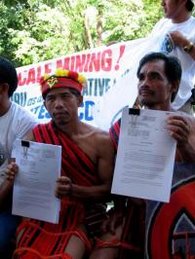Malaya July 27, 2006
BY JOJO DE GUZMAN
http://www.malaya.com.ph/jul27/envi1.html
KASIBU, Nueva Vizcaya – The possibility of mercury contamination of the Didipio River will be investigated by the place of Department of Environment and Natural Resources.
Gov. Luisa Lloren Cuaresma said Environment Secretary Angelo Reyes has agreed to look into illegal small-scale mining in Barangay Didipio and determine whether the activities has harmed communities particulary those who might have been directly exposed to mercury-contaminated water.
Cuaresma said Reyes "will see for himself the mining operation’s adverse consequences on the people and the environment."
Reyes’ planned visit is scheduled within the week or in early August and prompted by persistent reports of continued operations of small-scale miners utilizing deadly substances and unregulated explosives in the indigenous peoples-dominated barangay, which lies in the mountain boundary of Nueva Vizcaya and Quirino.
Last month, findings by the state-run Nueva Vizcaya State University (NVSU) here showed mercury contamination in the blood of some Didipio residents, reportedly as a result of the continued illegal operation of dynamite and chemically induced small-scale mining activities.
Earlier this month, Reyes ordered an investigation on possible mercury contamination.
Reportedly, Didipio’s major rivers – Camgat, Surong and Didipio –major sources of potable water and irrigation in the area, were now contaminated with the poisonous substance.
The NVSU probe team report was confirmed by the National Science Research Institute (NSRI) at the University of the Philippines and St. Luke’s Medical Center, where water and blood samples from the upland area were found positive of mercury contamination.
Even before the findings came out, Cuaresma has already been calling all concerned authorities for the immediate stop of all illegal mining activities in the area following the death of a number of small miners due to suffocation inside the illegally dug-up tunnels. It was also meant to stop indiscriminate blasting activities.
In nearby Quirino province, Gov. Pedro Bacani has expressed fear that the continued illegal mining activities might cause massive erosion or landslides, posing danger to villagers living in the immediate impact zone, especially those in the lowland areas in the Quirino towns of Nagtipunan, Cabarroguis and Aglipay.
Over the years, small-scale miners use mercury to extract gold with the aid of water, which is indiscriminately drained into nearby rivers, Bacani noted.
Penro Apigo, DENR provincial officer, said families in the affected area are facing grave danger. "Delikado talaga ang kanilang kalagayan lalu pa nga’t sa ilog din d’on sila naliligo at kumukuha ng inumin. This is dangerous and hazardous to their health," he said.
Reportedly the human intake of mercury-containing water or fish, accumulated over time, can impair a person’s ability to feel, see, move and taste, and it may even lead to death.
An official from the Australian Philippines Mining, Inc. (APMI), who requested anonymity, said illegal small-scale miners in Didipio use mercury to extract gold from ores. "After grinding the mineral-containing ores, they used mercury to separate the gold. Vaporizing mercury, a metallic liquid, in the heating process is dangerous to health," he said. APMI allocated for social development programs a total of $2.8 million and for environmental programs, $8.6 million.
He added that the Didipio mining project is set to start construction by September this year and begin mineral production one year after.
Employment from the project of APMI, a 100- percent owned Philippine subsidiary of Climax Mining Ltd. of Australia, is seen at 1500 during construction and development, 500 during commercial operation and 3,000 indirect employment created due to the employment multiplier.
Offcials here projected that total government taxes and fees to be collected from APMI will be at $131 million
Thursday, July 27, 2006
Subscribe to:
Post Comments (Atom)

No comments:
Post a Comment